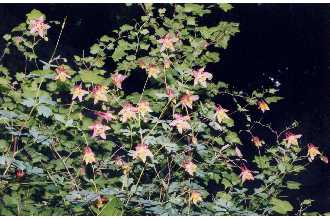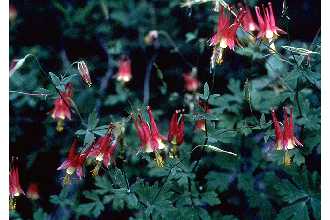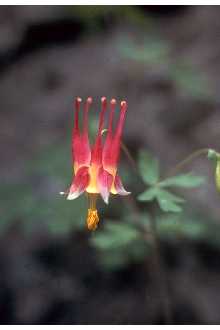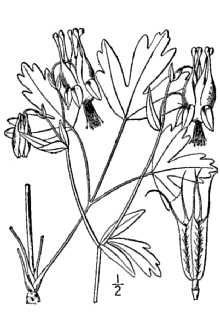Aquilegia canadensis L. var. eminens (Greene) B. Boivin
Scientific Name: Aquilegia canadensis L. var. eminens (Greene) B. Boivin
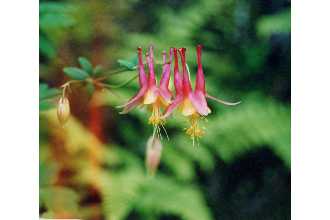
| General Information | |
|---|---|
| Usda Symbol | AQCAE |
| Group | Dicot |
| Life Cycle | Perennial |
| Growth Habits | Forb/herb |
| Native Locations | AQCAE |
Plant Guide
Alternate Names
Wild columbine, wild honeysuckle, meeting-houses, red-bell, Canada columbine, American columbine, rock-lily, jack-in-trousers, cluckies, Aquilegia australis, Aquilegia canadensis var. australis, Aquilegia canadensis var. coccinea, Aquilegia canadensis var. eminens, Aquilegia canadensis var. flaviflora, Aquilegia canadensis var. hybrida, Aquilegia canadensis var. latiuscula, Aquilegia canadensis var. phippenii, Aquilegia canadensis forma flaviflora, Aquilegia canadensis forma ecalcarata, Aquilegia canadensis forma albiflora, Aquilegia canadensis forma phippenii, Aquilegia coccinea, Aquilegia elegans, Aquilegia eminens, Aquilegia flaviflora, Aquilegia latiuscula, Aquilegia phoenicantha and Aquilegia variegata.
Uses
Ethnobotanic: Seeds from this plant have been used to treat ailments such as headaches, sore throats, stomatitis, heart problems, skin rash or itch caused by poison ivy, kidney and urinary problems, and fever. They have also been used for ceremonial medicines, perfume, and as additives to tobacco. Roots of this plant can be used to treat gastrointestinal ailments. Landscaping: Red columbine, in native or cultivated forms, is a popular garden perennial because it is hardy, lives approximately 3 to 5 years, and can readily regenerate by seed. It is also useful for woodland and meadow plantings. Wildlife: Red columbine is pollinated by hummingbirds, which may depend on the plant as an important nectar source. In addition, at least four bee species have been found to be effective pollinators of red columbine in southeastern Wisconsin and northwards. Jennifer Anderson 2002. USDA-NRCS PLANTS Database
Status
Red columbine is endangered in Florida. Please consult the PLANTS Web site (http://plants.usda. gov) and your State Department of Natural Resources for this plant’s current status (e.g. threatened or endangered species, state noxious status, and wetland indicator values).
Description
General: Buttercup Family (Ranunculaceae). Red columbine is a perennial herb that has short-lived fibrous roots and a vertical underground stem (caudex). It is 30-80 cm (12-30 in) tall, growing from the caudex. Compound leaves are distinctly divided into obovate leaflets. The flower is downward facing, with all petals prolonged backward into a tubular spur. Sepals are petal-like and typically red. Petals are yellow and become redder at the tip of the spur. Plant growth begins in early spring. This plant blooms from March to July and sets fruit in mid to late summer (June to August). Aboveground portions of Red columbine die back to the caudex in mid to late autumn. Distribution: Red Columbine is native to eastern and central North America and is found from Nova Scotia to Saskatchewan, south to northern Florida, western Oklahoma and eastern Texas. For current distribution, please consult the Plant Profile page for this species on the PLANTS Web site (http://plants.usda.gov). Habitat: Red columbine is found in dry to mesic or even low woods, especially along borders or clearings of oak-hickory, oak-maple and maple-basswood forests, black-oak savannas, cedar glades, pine woods, and mixed conifer hardwood forests. It can also be found on wooded to open rocky hillsides, bluffs, calcareous cliffs, outcrops, ledges, banks, beach ridges, gravelly shorelines, roadsides, quarries, and peat bogs.
Adaptation
The USDA Hardiness Zones for red columbine is 3 to 8. It grows in thin soils over granitic bedrock, steep hillsides of thin loess over limestone or quartzite bedrock, and on gravelly glacial marine soils. Because of highly variable genetic plasticity, red columbine populations can occur in a wide range of habitats from rich woods to rocky cliffs.
Establishment
This hardy eastern perennial is propagated by seed. Seed is mature and ready for collection when it turns black in the follicles. Collected seed should be stored in seedbags at temperatures of 5o to 6oC (~41oF) and can be stored up to 4 months. A 3 to 4 week period of moist stratification at 5oC may speed up germina-tion time but does not increase germination rate. Aquilegia canadensis seeds should be hand-sown into germination trays in greenhouse temperatures of 21o to 24oC (70o to 75oF). Germination will take place within 3 to 4 weeks, and supplemental lighting is not necessary. Soil in the germination trays must be kept evenly moist during germination. Fertilization may damage the foliage, so avoid application while in germination trays. Seedlings can be transplanted into plug cells following a 3-4 week period of root development. Plugs will need to be cut back to allow for air circulation over the media surface. Approximately 2 weeks prior to outplanting, plants should be exposed to lower greenhouse, or frost-free outdoor, temperatures. Although red columbine prefers soils that are well drained, loose, and slightly acidic, it will grow in medium that is loose and has a mixture of organic matter. It will not bloom during the first growing season. Germination procedures can begin in August and as late as November. Outplanting should take place in the spring (April). Red columbine can also be direct-seeded at a planting site in the fall or early spring. The general recommendation for wildflower seeding is 11 pounds per acre.
Management
Columbine species are little bothered by powdery mildew or broad mites. The waxy nature of the leaves sheds water-based pesticides. Red columbine is unpalatable to livestock but is sometimes browsed by deer. Red columbine can survive fire disturbance. Recolonization begins when the underground caudex resprouts following disturbance. Population growth continues by seed. Cultivars, Improved, and Selected Materials (and area of origin) Examples of cultivars include the ‘Canyon Vista,’ ‘Corbett,’ and ‘Nana’ columbines. These cultivars were developed for garden use to change the color intensity of the red and yellow flowers of the canadensis species. Native plant material is readily available from a number of growers, wholesalers, and retailers of native seed. The National Plant Materials Center (NPMC) in Shenandoah National Park produces columbine plugs, quart-size plants, and seed.
References
Agricultural Research Service 2003, Dr, Duke’s phytochemical and ethnobotanical databases, USDA-ARS-NGRL, Beltsville Agricultural Research Center, Beltsville, Anderson, J, Use soil moisture sensors to measure the soil moisture of Aquilegia canadensis L. var. eminens (Greene) B. Boivin.,, 2002, USDA-NRCS PLANTS Database, Version 3,5 (http://plants,usda,gov, 21 October 2004), National Plant Data Center, Baton Rouge, Davis, K,M, & J,L, Knjawski 2001,

